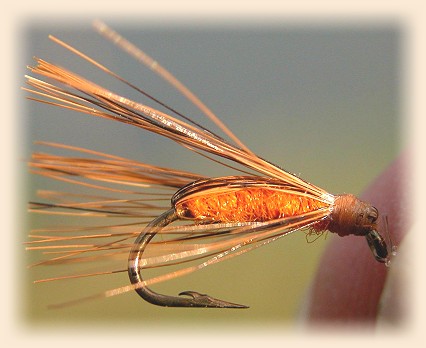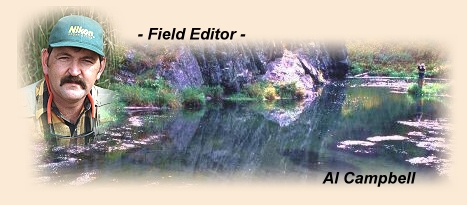|
We have all heard the argument a zillion times. In
fact, bringing it up again is akin to serving leftovers
to dignified company. I'm gonna do it anyway though.
I'll ask the question again. Which is more important;
having the right fly pattern, or having the right
presentation? There, I did it. Make it one zillion
and one.
Some folks argue that the right pattern is critical.
They will tell you emphatically that the wrong pattern,
no matter how it is presented, won't catch fish. If you
peak into their fly boxes, you'll discover thousands of
flies tied in every possible sub-species variation of
size and color for every hatch imaginable. And, they
catch fish.
Other guys will swear that presentation is the key. No
matter how precise the pattern, if it is presented wrong,
it won't catch fish. Their fly boxes are rather Spartan
in comparison to those of "right fly Fred." Their motto
is "get it close to the right pattern, and present it right,
and you'll catch fish." And, they do catch fish. In fact,
they catch as many fish as the "right fly" crowd.
I tend to believe both are important. I think the
right fly and the right presentation are crucial
for consistent success. However, I have a slightly
different view than most on what constitutes the "right
fly" and the "right presentation." That bothers some
people a lot. In their mind, I have a total disregard
for the sacred principles of fly-fishing. In this
case, I'm either right or wrong. There is no gray
ground of compromise in the middle.
Here is where it gets a bit sticky. I believe the right
fly is often a pattern called a
Shwapf (swept hackle, wingless, all-purpose fly).
If the fish are after dry flies, I'll put floatant on
a Shwapf, and fish it dry with good success. If they
want emergers or wet flies, I frequently choose the Shwapf.
I often choose a Shwapf when nymphs or streamers are the required offering.

Some folks would argue that my choices here make me a
presentationist. To a degree, they are right. I often
vary the presentation of that same fly to meet the current
needs. However, I choose the size and color of the Shwapf
to match the current hatch. That would arguably be the
symptoms of a hatch-matcher. The fact that I'm so
successful in this strategy mystifies that famed
hatch-matcher James Castwell. It bothers him so much,
he asked me to write this article and explain my reasoning.
First of all, I believe many flies are tied to match
what the fisherman thinks they should look like, not
what the fish think they should look like. If you
spend very much time observing insects (alive and dead),
on or in the water, you'll quickly notice that they all
have some common characteristics when viewed from
underneath. They all have a general slope toward
the back of their bodies. Their legs are often
either on the water or in the water, and they often
extend toward the back of the insect, especially if
the insect is either dying, dead, or having a hard
time escaping the surface of the water. The body
of the insect is often touching the water, or just
barely above the water. In the case of emerging
insects, the legs are often trailing the insect in
some form. In the case of dead insects, the legs
often trail the insect too.
Looking at the Shwapf, I see many of these characteristics.
It was designed to have those characteristics. If I apply
floatant and let it drift on the surface, the hair under
the fly will either support the fly with the body partially
touching the water, or the body will support the fly
allowing the bottom hairs to drift just under the fly
like the legs of a struggling insect. Since the Shwapf
can be tied in many sizes and colors, I can match most
insect hatches with one pattern in several colors and
sizes. And, that match will appear more correct to
the fish than many of the patterns we use and think
look right to our eyes. If you think about it, do
you know of any insects that drift along on the water
supported by just their front legs and their tails?
They just don't act that way.
If you observe emerging insects, they usually
utilize some sort of propulsion to move from
the bottom to the top of the water. During
this move, their legs spend most or at least
some of the time below and behind their bodies.
With legs on the bottom and either immature wings
or (in some cases) a bubble of air on top; the
Shwapf does a fair job of imitating this look.
In fact, it does a better job than many of the
flies that are supposed to look natural to the
fish. If my Shwapf is about the same color and
size of the natural insect, and I match the natural
movement of the insect, I have an imitation that
looks good enough to eat. This is especially true
if the emerging insect is a caddisfly.
When caddisflies and stoneflies return to the water
to lay their eggs, they often skim the water with
their legs and tails as they fly upstream. The
Shwapf can easily be fished in the same manner.
Its taper and form resemble the natural look of
an egg-laying caddis or stonefly. The shape is
just right to easily skitter it across the surface
of the water, in the same manner that the natural
insects move.
Insects that expire in or on the water are often
rough looking. Their wings and legs often slope
out from the body in the same fashion as the hairs
on the Shwapf. This is true of insects that just
finished laying eggs and those that didn't survive
the attempt to emerge as adults. This one pattern,
tied in the right size and color, can do a good job
of imitating both.
If small crayfish or similar crustaceans like a scud
are the items on the menu, the Shwapf is a good
choice. It looks enough like both to fool a fish,
if it's fished the right way. Crayfish have enough
legs and claws sticking out to the side and behind
them when they swim, to look like a large Shwapf.
Same is true for scuds and even sowbugs. If the
presentation is right, the fly looks enough like
the natural to fool a fish.
Using those principles, I fished the Shwapf in several
sizes and colors all day on Tuesday of the Idaho Fish-In.
I was able to successfully match the October Caddis, a
PMD hatch, a smaller caddis hatch, and another small,
light mayfly hatch. I fished it dry, wet, and as an
emerger. I hooked more than 70 fish and landed 48.
I was proving a point. I believe I had the right fly
to match the hatch, and with the right presentation,
so did the fish.
The Shwapf is more than just a pattern. It is a style
of fly that can be adapted in size and color to match
more of the naturally occurring insects than any of
the other flies I have seen. It has the characteristics
needed to look right in or on the water. From any angle
or any posture, it just looks more like something natural
to eat, than any of the other imitations I tie. The fish
seem to agree with that thought.
I'm not trying to coax anybody into anything here.
Fish what you want, where you want and when you want.
However, if you wonder why I put so much faith in one
style of fly, this is your answer. My successes with
this style of fly seem to support my observations on
the subject. It appears the fish view it the same
way I do. And, that is the most important reason I
tie and use the Shwapf.
~ AC
|



